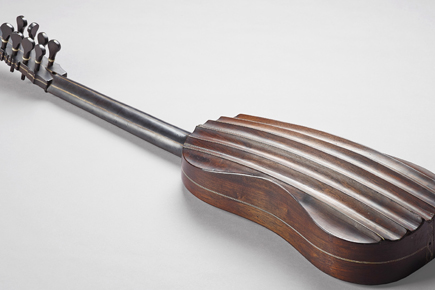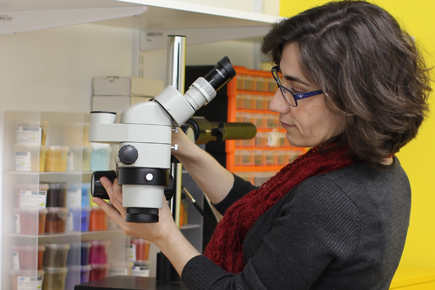Museum blog: Meet the Conservator
Friday 12 May 2017
Name
Susana
Who
Conservator
Favourite object(s) in the collection
I definitely have a favourite! I love the Belchior Dias guitar. It’s Portuguese (like me) and made in 1581. This was the year that King Philip II of Spain became King of Portugal. The guitar is beautiful and very well made. It has had some alterations to its original condition, but it’s believed to be the earliest guitar in existence.

How did you come to conservation?
I studied art conservation in Portugal. At that time no-one seemed to be specialising in conservation of musical instruments and, because I was a music student as well and no other fields really caught my attention or love, one of my professors said 'You know Susana, I've got this journal from CIMCIM (International Committee of Museums and Collections of Instruments and Music) – you might be interested in taking a look'. So I looked at the journals and thought 'This might be fun!' I wrote to the President of the Committee who told me about 3 places where I could study, one of which was the National Music Museum in Vermillion, South Dakota. So I went there for my final year placement and then stayed on for my Masters degree in History of Musical Instruments, with emphasis on conservation.
Do you have a musical background or play an instrument?
I did play recorder seriously, mainly Baroque music. Now I still play in church and for fun with friends. I did once play saxophone but I would rather not write that on my CV!
What are you doing today?
I'm sorting out documentation that I gathered during the decanting of the collection at the end of last year. Some objects are still here; and I'm documenting their condition before they go to storage.
Can you tell us a bit about what you do in the Museum?
A conservato's main goal is to ensure the preservation of the heritage. Making sure the objects in the care of a museum are in good condition, or at least do not deteriorate further. That includes preventative conservation, when you take into account temperature, humidity and light that could induce damage, but also by taking some direct action on the instruments. Not in the way a luthier would perhaps restore an instrument, but preserving every detail and feature using materials that are proven to last for many years and will not cause any further harm. In the past, people used materials to the best of their knowledge but there was not as much conservation science involved. Later, sometimes, materials would be found to be harmful to the object. Today our main goal is to interfere as little as possible with the objects, using materials that can be reversible today, tomorrow, or even in 100 years or more.
What projects do you have going on right now?
At the moment the main project is to get documentation ready in order to establish our priorities for conservation over the next 2-3 years. All the data will be looked at by the whole team and we will decide a plan of action for each object, especially the ones that will be going in the new display.
In the meantime I have some objects here that were too fragile to travel to storage so I am doing some consolidation work, for example consolidating some gilding and its base layers on an eighteenth century French harp.
What’s the best bit about your job?
I love the diversity. No two days are ever the same. Constant, constant, constant learning is the best part of it. I never get bored.
What are the challenges?
Well, the diversity of the work can often make it challenging to decide a best way forward. There's always a question; what shall I do first or will what I'm thinking today still be valid tomorrow? Today we have some science available, but in the future we will have much more, so it's making sure I use the right materials and take the right action so that my decisions and actions today will not have a negative impact on the objects in the future.
Why are you important to the museum?
Well first of all I'm really nice! No seriously, we have a really nice team and we all have our functions, working together for the benefit of the collection. Ultimately however, the conservator is physically the closest person to the objects, maybe more than any other member of the team. We get to handle them more, learn from their physical characteristics, and by doing so we are able to produce content and data that can be used by the team, or by scientists or researchers. I'm on the front line.
Can you tell us a bit about the RMC collections in your own words?
This collection is very strong for having some really early examples, or believed to be the earliest examples, of musical instruments. This is essential to our understanding of the history of instrument making and music! The Dias guitar and the clavicytherium (upright harpsichord from 1480) are our earliest examples, and we need to do further scientific study to learn more about them to make sure that everything we have written about them is consistent with what science can show us; pigment and material identification, etc. Bringing science in to bridge the gaps in our knowledge and make sure everything we say up until now is correct. These early items, after they are studied and understood, could be amazingly important items of world heritage.
On the other hand, for students or visitors that want to study the evolution of instruments we have a good brass, clarinet and flute collection in large quantities. We don't have huge amounts of percussion or non-Western instruments, but those that we have are extremely interesting and should be studied or compared with other items in other collections. We may not have the most extensive collection of music of keyboards, for example, but we have some amazingly important keyboards, like the clavicytherium, the Trasuntino harpsichord and the virginal by Celestini.
What are you most excited about for the future of the Museum?
I can't wait to do some scientific study on the clavicytherium and the Dias guitar! We need to look at the physical objects within a historical context, for instance, look at the Dias guitar according to the canons and regulations that existed in Portugal at that time for guitar makers. For me it's very interesting to be able to study an object that was made in my country which might be the earliest of its kind. For me it's not the most important thing to confirm it as the earliest but to make sure that what we tell our audiences about this instrument is, to the best of our knowledge, truthful. This is true for all other objects in the collection. Of course, above all, I am really excited that we can have a physical space that will be up to the necessary standards to house, protect and exhibit our collection in the best possible manner.
Lastly, if you could be a musical instrument what would you be and why?
I know I play the recorder already, but I think I would be a recorder! The recorder looks quite unassuming without too many embellishments but is very versatile and the sound is very real and heart-felt, like me.
Thanks Susana, all the best!
Our Meet the Team series continues next week.








